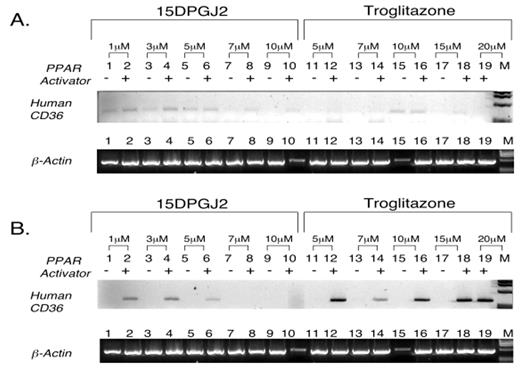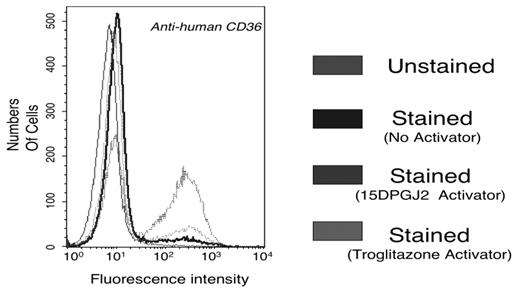Abstract
CD36 is a receptor for thrombospondin and is present on megakaryocytes and platelets. It may be critical for normal megakaryocyte-formation and platelet function. The human CD36 gene locus extends 38.3 kb along chromosome 7 at position 7q11.2. Six distinct promoters (1A-1F) have been described that flank corresponding alternatively spliced first exons. To date the activity of these six promoters has not been tested in the megakaryocytic lineage and understanding the regulated expression of the CD36 gene may provide additional insights into the biology of this receptor. The 1B promoter, which is active in monocytes and adipocytes possesses a PPAR γ Direct Repeat (DR-1) binding site at position -260bp that is inducible in those same lineages with PPAR γ ligands. Recent studies have shown that primary megakaryocytes, platelets and the megakaryocyte line MEG-01 cells express PPARγ. To elucidate the molecular basis for CD36 gene expression in megakaryocytes and to query whether PPARγ plays a role in CD36 expression in this lineage we treated two megakaryocytic cell lines HEL and CHRF with increasing doses of two PPARγ ligands, 15DPGJ2, an arachadonic acid (AA) metabolite and Troglitazone, a thiazolidinedione drug administered to diabetics. RT-PCR studies using an exon 1A/exon 3 primer set or an exon 1B/exon 3 primer set established that CD36 mRNA from both promoters was expressed in these two lineages. Further these studies showed that HEL cells exhibited ligand dependent transactivation of the 1B but not the 1A promoter to both 15DPGJ2 and Troglitazone. CHRF cells did not demonstrate a drug dependent induction of either promoter. However, flow cytometry studies using a FITC conjugated anti-human CD36 antibody revealed that both HEL and CHRF cells had significant increased surface expression of the CD36 receptor. CHRF cells in particular had a 23 fold increase in surface CD36 over vehicle treated controls. Western Blot Analysis demonstrated that this increase in surface receptor quantity was secondary to drug-induced increases in the steady state protein levels. The relative increase in protein level was consistent with the mRNA levels determined by our RT-PCR results. We conclude that the 1B promoter is PPARγ responsive in HEL cells and that an alternate promoter perhaps 1C, 1D, 1E, 1F or a novel promoter is PPAR gamma responsive in CHRF cells. These data may have clinical implications for diabetics currently undergoing thiazolidinedione drug treatment with troglitazone as CD36 increases on the platelet surface lead to increased AA uptake and circulating platelet hyperactivation. These represent the first studies showing the nuclear receptor PPARγ’s involvement in regulating gene expression in megakaryocytes.
Disclosure: No relevant conflicts of interest to declare.
Author notes
Corresponding author



